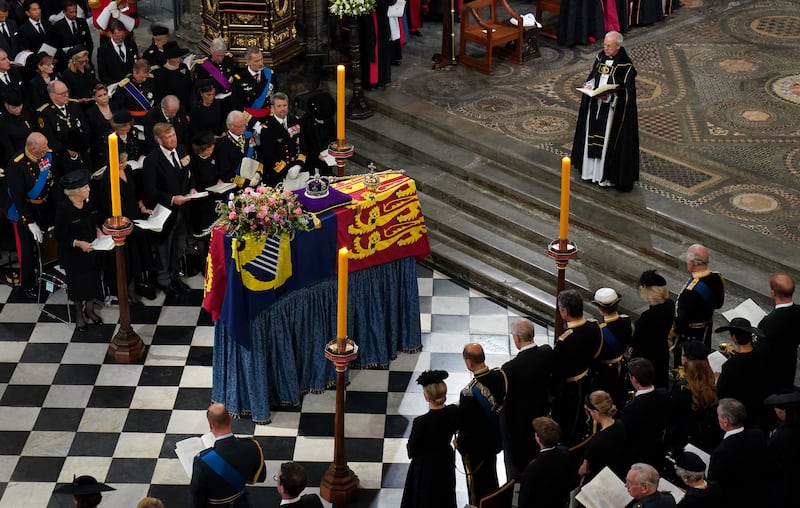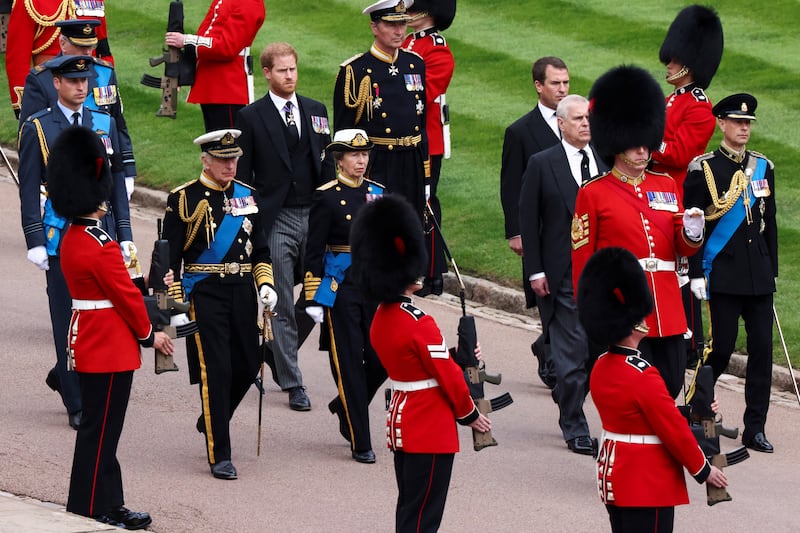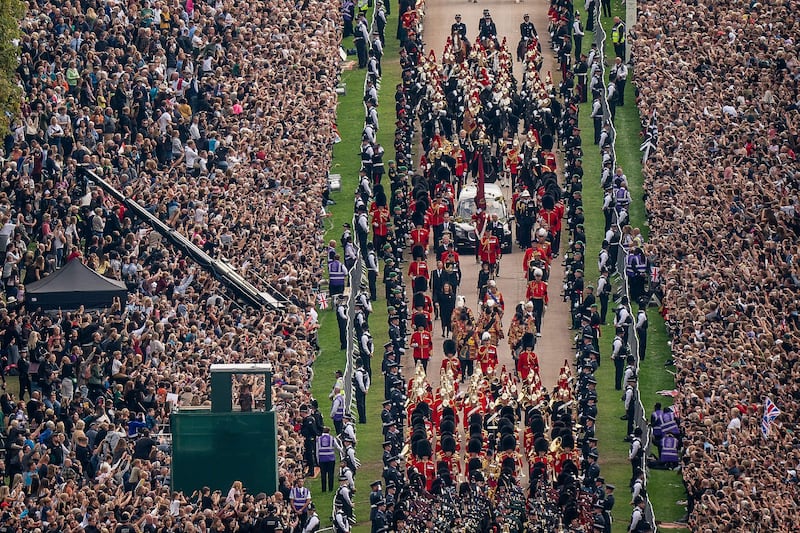Nothing became Queen Elizabeth’s life in London like her leaving of it. If there was any doubt over the past few days, as the theatres and the posh shops bore elegiac notices and the same black and white photograph, as the Mall was decorated with a mile of Union Jacks and the flowers kept coming and the infrastructure of the city was re-engineered for a week of mourning, then her funeral service confirmed that the end of an age had arrived.
While the guests arrived early in Westminster, a vast army of mourners scrambled to catch a glimpse of the day for themselves. The first task for the thousands scurrying around the catacombs of the London Underground- rarely if ever graced by royal footsteps — was which station to jump out. The information, delivered in staccato and incomprehensible bursts over the “sound system” was not promising. There were delays at Hyde Park Corner, where the queen’s casket would be transferred from the gun carriage to the state hearse before leaving the city for good. In and around Westminster was already impassable. A huge crowd alighted at Knightsbridge to discover thousands of people walking briskly away from the Arch: the road was already closed.
The mourners began to consult the many police officers who stood at every crossing point. All the big stores — Harrods, Harvey Nichols — were closed for the day and posted sombre notices in their windows. Anyone over the age of 30 would, of course, remember that these streets were once the heart of Diana’s old stomping ground. All the gone luncheons, the gone Fleet Street gossip merchants, the snappers waiting outside San Lorenzo for a shot of the latest outfit, the new hairdo: these were the streets that took centre stage in the full decade and a half when Diana Spencer was the first and last in royal fascination. The Al Fayads no longer own Harrods — it was sold to Qatar Holdings in 2010 — but the store played a prominent role when the city was possessed by an explicit form of grief 25 Septembers ago.
The broadcast coverage has not stopped since the queen’s death in Balmoral was announced 11 days ago and through the endless chatter and introspection, Diana’s name has been delicately sidestepped. And yet the comparison with this event is unavoidable, not just in the staggering sea of floral tributes which swept in from all corners of the United Kingdom to the gates of the palace and Green Park, but in the fact that the last person to evoke such an exhibition of British public mourning was Diana. She did not, of course, lie in state that September — and perhaps it’s just as well for the monarchy. The line of mourners would have smashed all records.
RM Block
On the street, the crowd wanted to know where they should go. When would the cortege pass here?
“Well”, a young policeman said. “The king will be coming through here. She won’t. Her Majesty.”
“She won’t pass Harrods,” somebody said.
“Is that really so?” his companion said.
“Well, no. Not officially. But yeah. That’s what I heard anyway.”

History swirled. On television, it took the sharp-eyed jewellery experts just minutes to identify the four-strand pearl choker around the neck of the new Princess Catherine of Wales as one of the late queen’s favourite pieces, worn also by Diana. The personages come and go: the baubles and symbols — the imperial crown, the orb and scepter, the big guns hauled up through Hyde Park- are there to underline the inheritance of tradition and sovereign wealth and duty.
In Hyde Park, the big screens showed the service taking place in Westminster Abbey. The television screens cannot hope to capture the full impact of those three and a half thousand marchers in uniforms, the horse hooves on pavement, the gun carriage and that small coffin draped in the royal standard.
It felt as though they have been marching all week, the royals, in full military splendour, except, once again for Andrew and Harry. “But wasn’t Harry in the war?” asked a voice in the crowd, confused.
But all the previous processions paled against the full force of this last march.
For such a vast crowd, the atmosphere along the streets and avenues was subdued. The morning had that bank holiday city sluggishness, but it was more than that. The funeral of a monarch is an exhausting business for everyone but the deceased. The royals, during their daily appearances on the television screens, look shattered. The police, stretched at even intervals on the entire length of the walk, looked out on their feet, running 12-hour shifts throughout the week and now in the critical hour of a military and logistical operation which was supposed to reflect the true, idealised soul of Britain’s royal and imperial tradition.
There were six monarchs in the 20th century. But the queen’s father, George VI, was on the throne for just 15 years. His predecessor Edward VIII didn’t even last a year. It was her century. Still, this is the year 2022. Distractions are many and attention spans have diminished. Some among the many thousands stood and listened to the haunting choral music drifting across the park as the service began. Others vaped. Mourners drank their coffees, they messaged friends, they watched the service on their phones. Others sat on the yellowed grass and waited because in an hour or so, the queen would come to them, sweeping past their very eyes on her way out of London for the last time.

Everything went as clockwork. The great and the good — 500 world leaders, royals of major and minor significance, other dignitaries — obediently filed into the abbey at the designated hour, all looking vaguely stunned at not being the centre of attention. All of Britain’s living prime ministers had been assembled. There were charity workers and former staff in the building.
At 10.45am, the service was entrusted to the care of the church and military. The tolling of a single bell. The bearer party from the Grenadier Guards carrying the coffin from Westminster Hall, through which hundreds of thousands of people filed over the past few days. And at precisely 10.45am, the cortege was on the move down Parliament Square, as on the television the broadcasters explained to the audience watching around the United Kingdom, around the world, the significance of the small flourishes and gestures. The rosemary in the floral wreaths on the casket for remembrance; myrtle for a happy marriage and oak to symbolise the strength of love. A handwritten note from her eldest, the new king, placed prominently and bearing no ink smudges.
Charles III led the family mourners. With him walked Anne, the Princess Royal, the Duke of York and the Earl of Wessex. Behind them William, the new Prince of Wales and his brother Harry, the Duke of Sussex. It has been a fractious, turbulent few years for the family, for “the Firm”. It is seldom that they are seen in public as one entity. And this will be the final occasion when the impenetrable aura of Queen Elizabeth can shield them from the criticism of the outside world — and from their own foibles. Until now, it was she who carried the weight of responsibility for the monarchy. Even as they gathered for the state funeral, all of that was transferring to their shoulders.
A choral rendition of I Am The Resurrection sounded as she entered the abbey. By then, it was clear that the midnight practices and the laborious planning and the peculiar British genius for military and funeral theatre had worked. The day would be conducted with immaculate precision and solemnity. There would be no errors.
“Her late majesty famously declared on her 21st birthday broadcast that her whole life would be dedicated to serving the nation and commonwealth. Rarely has such a promise been so well kept. Few leaders receive the outpouring of love that we have seen,” said Reverend Justin Welby, the Archbishop of Canterbury, in his homily. The political titans in the ancient building might have whispered Amen to that.
“Death is swallowed up in victory,” sounded the loudspeakers in Hyde Park while the crowd shuffled, getting tired from standing for so long.
“O Death, where is thy sting.”

At 11.55am, after the sounding of the Last Post, came the two-minute silence to be observed across the land. A midnight quiet fell over Hyde Park and then the vast orchestration of grief was on the move again, away from the abbey and back towards Buckingham Palace where the queen had made her first appearance on the balcony 95 years ago. Staff waited, heads bowed. Canon guns fired in the park as the gun-carriage made its way up to Wellington Arch, where the coffin would be carried to the state hearse. All of this was just a stone’s throw from her childhood home at Piccadilly, bombed in the Blitz and where the Intercontinental Hotel now stands. A bolt of energy moved through the front line of the crowd and they sharpened and prepared their camera apertures to capture the moment.
The cortege passed by quickly: history on the move is fluid and evasive. Shortly afterwards, another state car containing the grave drawn features of Princess Anne. The king’s car was escorted along a separate route, just as the police officer had promised. On a morning crowded with both symbols and explicit references of mortality, the new king would only be human had he wondered, even momentarily, if the public will turn out in such numbers and with such manifest goodwill and affection again. Had he wondered: will they mourn me like this?
Afterwards, the roads stayed sealed for far too long. The subjects wanted to get home. People were becoming cranky. It was impossible to follow the progression of the day by radio: a kind of mania had overtaken the commentariat as they sought to burnish every single aspect of the day with historical significance and majesty. They could perhaps be forgiven, because there was nothing left to say. The day been a visual wonderland: a beautifully planned and executed pageant containing the sights and sounds of a Great Britain that were far more relevant at the beginning of her long life than now, at its end.
Few institutions have used the television age as shrewdly as the royals and Queen Elizabeth’s last act was to use all the ceremonial pomp and brass and medals of the Britannia’s vastly diminished army and her church choirs, the historical buildings and her own decades of unblemished hauteur to cast a golden hue over the surviving royals, at least for the remains of the day.
And the true reward for those who had stood for hours was not that fleeting glimpse of a sad-faced royal daughter. No, it was the solemn sensation that also fleeing the park and the city behind that hearse was the final connection with the Britain which the older generations venerate and wish for when they are singing their anthem. They — her family, the squabbling political classes and the public — may have said goodbye to her yesterday. But it will take them a long time to absorb the fact that she is gone.





















